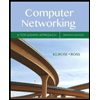
Computer Networking: A Top-Down Approach (7th Edition)
7th Edition
ISBN: 9780133594140
Author: James Kurose, Keith Ross
Publisher: PEARSON
expand_more
expand_more
format_list_bulleted
Question
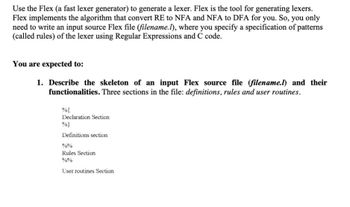
Transcribed Image Text:Use the Flex (a fast lexer generator) to generate a lexer. Flex is the tool for generating lexers.
Flex implements the algorithm that convert RE to NFA and NFA to DFA for you. So, you only
need to write an input source Flex file (filename.I), where you specify a specification of patterns
(called rules) of the lexer using Regular Expressions and C code.
You are expected to:
1. Describe the skeleton of an input Flex source file (filename.l) and their
functionalities. Three sections in the file: definitions, rules and user routines.
%{
Declaration Section
Definitions section
%%
Rules Section
User routines Section
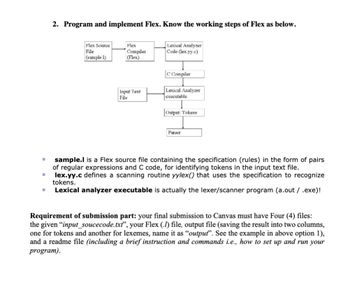
Transcribed Image Text:m
■
2. Program and implement Flex. Know the working steps of Flex as below.
Flex Source
File
(sample 1)
Flex
Compiler
(Flex)
Input Text
File
Lexical Analyzer
Code (lex.yy.c)
C Compiler
Lexical Analyzer
executable
Output: Tokens
Parser
sample.I is a Flex source file containing the specification (rules) in the form of pairs
of regular expressions and C code, for identifying tokens in the input text file.
lex.yy.c defines a scanning routine yylex() that uses the specification to recognize
tokens.
Lexical analyzer executable is actually the lexer/scanner program (a.out/ .exe)!
Requirement of submission part: your final submission to Canvas must have Four (4) files:
the given "input_soucecode.txt", your Flex (.) file, output file (saving the result into two columns,
one for tokens and another for lexemes, name it as "output". See the example in above option 1),
and a readme file (including a brief instruction and commands i.e., how to set up and run your
program).
Expert Solution
This question has been solved!
Explore an expertly crafted, step-by-step solution for a thorough understanding of key concepts.
This is a popular solution
Trending nowThis is a popular solution!
Step by stepSolved in 2 steps

Knowledge Booster
Similar questions
- You guys use AI tool to answer. Last time I found plagiarism and AI detection in my answer. Now If you will use these things I'll surely give multiple downvotes and will report ⚠️ sure.arrow_forwardDateType keeps only the integer representation of the month,day, and year. When a month is wanted in string form, the string iscalculated. An alternate approach would be to add a string field tothe date and calculate and store the string representation in theInitialize function. Which methods would have to bechanged? Would this change make the use of an if statement tofind the appropriate string more or less attractive? Write the code in C++for this if statement.arrow_forwardUsing C++ Using your own creativity, make a set of function templates that have these features: This function must return a value. A function template with 1 template parameter, T. And, any other parameters you want. A function template with 2 template parameters, T1 and T2. And, any other parameters you want Within main (): Call your template functions and demonstrate how they work. Construct objects and show off your amazing programming skills!arrow_forward
- Could I get an example of a program writen in C that uses qsort() to sort its command line vector argv by the length of the strings? This is part of my first project and I don't understand pointers very well. If you have a video on how it is done that would work too. I looked at the meterial provided to me and I still cant rap my head around it. If this is to big of a question if you could baby step me through how pointers work that would be a great help. Thank youarrow_forwardin C program pleasearrow_forwardin c++ codearrow_forward
- Help with this. Solve the Heads-or-Tails problem in C or C++. Read the H-or-T data from either a file or from STDIN. Reportthe result and related statistics to STDOUT. Report any errors to STDERR:a. In an effort to find something to do during self-quarantine, your friend flips a coin many times andcarefully records the result of each flip in a character vector using either H or T. Write a functionprogram called longestRun that reads these characters from a file and then analyzes them to find thelargest number of consecutive heads or tails. It must return/display two values: (1) the numbercorresponding to how many max consecutive heads or tails were thrown in a row and (2) thecharacter H or T depending upon whether it was Heads or Tails that was thrown the most times. Inthe event of a tie for the longest run, return the character B for both the text file is HTHHTTTHHTHHHTHTHTHHHHHTTHHHHHHHHHHHHTTTTTTTTTHarrow_forwardProvide Full C++ Code In this checkpoint, your goal is to find the longest consecutive sequence of a STR (Short Tandem Repeats) in a DNA sequence. The main() function is already written for you. You will implement the function int numOccurrences(string& STR, string& sequence). Without even understanding what functions do in C++, all you need to know, at this point, is that you have access to the string STR of which you have to find the length of the largest consecutive occurrence in the string sequence. For example, if input sequence is: AGACGGGTTACCATGACTATCTATCTATCTATCTATCTATCTATCTATCACGTACGTACGTATCGAGATAGATAGATAGATAGATCCTCGACTTCGATCGCAATGAATGCCAATAGACAAAA then numOccurrences("AGAT", sequence) should return 5 numOccurrences("TATC", sequence) should return 8 if input sequence is: AACCCTGCGCGCGCGCGATCTATCTATCTATCTATCCAGCATTAGCTAGCATCAAGATAGATAGATGAATTTCGAAATGAATGAATGAATGAATGAATGAATG then numOccurrences("AATG", sequence) should return 7 numOccurrences("TATC", sequence) should…arrow_forward
arrow_back_ios
arrow_forward_ios
Recommended textbooks for you
 Computer Networking: A Top-Down Approach (7th Edi...Computer EngineeringISBN:9780133594140Author:James Kurose, Keith RossPublisher:PEARSON
Computer Networking: A Top-Down Approach (7th Edi...Computer EngineeringISBN:9780133594140Author:James Kurose, Keith RossPublisher:PEARSON Computer Organization and Design MIPS Edition, Fi...Computer EngineeringISBN:9780124077263Author:David A. Patterson, John L. HennessyPublisher:Elsevier Science
Computer Organization and Design MIPS Edition, Fi...Computer EngineeringISBN:9780124077263Author:David A. Patterson, John L. HennessyPublisher:Elsevier Science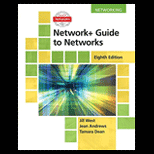 Network+ Guide to Networks (MindTap Course List)Computer EngineeringISBN:9781337569330Author:Jill West, Tamara Dean, Jean AndrewsPublisher:Cengage Learning
Network+ Guide to Networks (MindTap Course List)Computer EngineeringISBN:9781337569330Author:Jill West, Tamara Dean, Jean AndrewsPublisher:Cengage Learning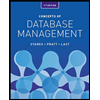 Concepts of Database ManagementComputer EngineeringISBN:9781337093422Author:Joy L. Starks, Philip J. Pratt, Mary Z. LastPublisher:Cengage Learning
Concepts of Database ManagementComputer EngineeringISBN:9781337093422Author:Joy L. Starks, Philip J. Pratt, Mary Z. LastPublisher:Cengage Learning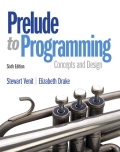 Prelude to ProgrammingComputer EngineeringISBN:9780133750423Author:VENIT, StewartPublisher:Pearson Education
Prelude to ProgrammingComputer EngineeringISBN:9780133750423Author:VENIT, StewartPublisher:Pearson Education Sc Business Data Communications and Networking, T...Computer EngineeringISBN:9781119368830Author:FITZGERALDPublisher:WILEY
Sc Business Data Communications and Networking, T...Computer EngineeringISBN:9781119368830Author:FITZGERALDPublisher:WILEY

Computer Networking: A Top-Down Approach (7th Edi...
Computer Engineering
ISBN:9780133594140
Author:James Kurose, Keith Ross
Publisher:PEARSON

Computer Organization and Design MIPS Edition, Fi...
Computer Engineering
ISBN:9780124077263
Author:David A. Patterson, John L. Hennessy
Publisher:Elsevier Science

Network+ Guide to Networks (MindTap Course List)
Computer Engineering
ISBN:9781337569330
Author:Jill West, Tamara Dean, Jean Andrews
Publisher:Cengage Learning

Concepts of Database Management
Computer Engineering
ISBN:9781337093422
Author:Joy L. Starks, Philip J. Pratt, Mary Z. Last
Publisher:Cengage Learning

Prelude to Programming
Computer Engineering
ISBN:9780133750423
Author:VENIT, Stewart
Publisher:Pearson Education

Sc Business Data Communications and Networking, T...
Computer Engineering
ISBN:9781119368830
Author:FITZGERALD
Publisher:WILEY